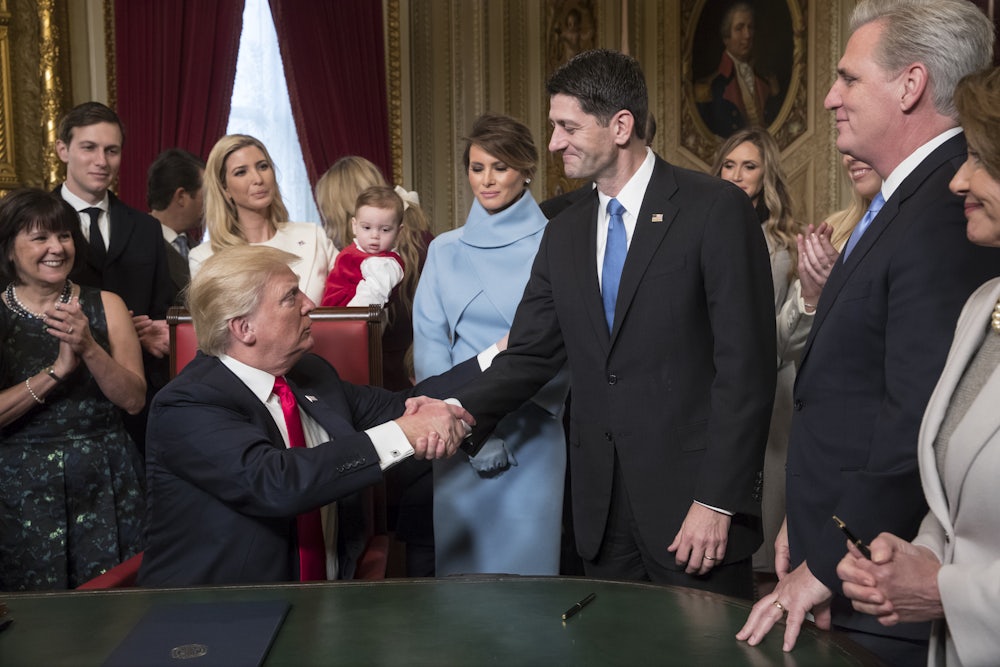The American Health Care Act is a misnamed, regressive tax-cut bill meant to fool you into thinking its primary purpose is improving the health care system. But the incredible cruelty of the Republican legislation didn’t become clear until Monday, when the Congressional Budget Office—led by a conservative economist whom House Speaker Paul Ryan personally selected—estimated it would undo nearly all of the coverage gains we’ve seen under the Affordable Care Act, creating human tragedy on a scale far greater than even pessimistic analysts imagined.
Republicans claim that Trumpcare is a simple matter of keeping their promise to repeal Obamacare. But if keeping promises were their guiding principle, they wouldn’t be ignoring the other ones they and President Donald Trump made: to preserve coverage gains and lower costs, and in doing so take care of people on the flip side of repeal. They are instead attempting to break those promises as swiftly and completely as possible, and at the expense not mainly of liberal Obamacare supporters, but of the very voters most inclined to have believed the lies. The swindle is greater than even we imagined.
Amid all the deception, Republicans have been fairly forthright about why they’ve made Obamacare repeal their first priority: It is so that they can ultimately reform the tax code on a permanent basis. Congressional budget rules exempt certain tax and spending bills from filibusters, but only if they don’t incur long-term deficits. It is very hard to cut taxes regressively and permanently without either building a partisan supermajority or figuring out a way to pay for the tax cuts. As George W. Bush–era Republicans learned, if you use the budget rules to pass a large deficit-financed tax cut, the tax cut will eventually expire.
Repealing Obamacare offers Republicans a way out of that trap, because it pairs eliminating (or indefinitely delaying) all of the ACA’s progressive tax increases with gutting the financial assistance the law provides to help millions of people afford care. It’s spoken of as “Obamacare repeal,” but it’s equivalently a large tax cut for the rich paid for by taking insurance away from the working class and poor. This filibuster-proof tax cut, in other words, would be permanent. And by reducing the revenue baseline, Republicans could make separate, deficit-neutral reforms to the tax code without having to sacrifice their goal of reducing the top marginal rate: all of the iniquity of the Bush tax cuts, without the automatic sunset.
This strategic imperative revealed something important about GOP priorities: that tax cuts outrank health policy in the Republican policy schema. But using Monday’s CBO report, we can sketch these priorities with greater precision, and the picture that emerges is vicious.
If Republicans wanted to cut taxes on the rich, they could cut taxes on the rich (by zeroing out Obamacare’s taxes, or cutting other taxes or both) and distribute trillions of dollars in revenue up the income scale without creating a vast humanitarian crisis as collateral damage. The 14 million people who will lose their insurance immediately under AHCA, and the 24 million who will be uninsured 10 years from now as a consequence of it, are necessary not so that Republicans can cut taxes per se, but so that the tax cuts won’t expire automatically. These millions of uninsured serve only to make the giant GOP tax cut for the rich permanent, as opposed to merely 10 years long.
The irony is that for all the GOP’s vindictiveness, the collateral damage would be borne disproportionately by Trump’s own supporters. By phasing out the ACA’s Medicaid expansion, Trumpcare would leave the poor and near-poor far worse off, including the white rural poor in states critical to Trump’s victory.
But it’s in the private market where the Trump base gets truly hammered. The ACA works in part by guaranteeing that subsidies increase automatically when premiums rise or incomes fall, limiting the public’s exposure to increasing health care costs. Trumpcare would give almost everyone of the same age the same amount of money, regardless of income or local insurance trends. By severing those two links, Trumpcare imposes huge price increases on the near-poor and people who don’t live in cities (where competition tends to drive prices down). Indeed, the rural, elderly poor get whacked three different ways.
Although average premiums would increase prior to 2020 and decrease starting in 2020, CBO and JCT estimate that changes in premiums relative to those under current law would differ significantly for people of different ages because of a change in age-rating rules. Under the legislation, insurers would be allowed to generally charge five times more for older enrollees than younger ones rather than three times more as under current law, substantially reducing premiums for young adults and substantially raising premiums for older people.
According to the CBO, a typical low-income 64-year-old’s out-of-pocket premium would jump from $1,700 a year to $14,600 a year by 2026. At $500 a pop, that’s nearly 26 iPhones. In parts of Trump territory, the increase would be even greater.
Republicans have the power to pass this legislation anyhow, if they can muster the will. What they can’t be allowed to do is claim that they are motivated by the sanctity of political promises. This bill breaks Trump’s promise not to cut Medicaid, it breaks the GOP’s broader promise to provide people relief from steep premiums and deductibles, and it breaks their explicit promise that millions of people won’t lose insurance on their watch. As central as Obamacare repeal has been to the GOP’s political identity, they never let on to anyone who trusted them that their rationale was to give millionaires huge tax cuts and the peace of mind that those cuts won’t expire.
